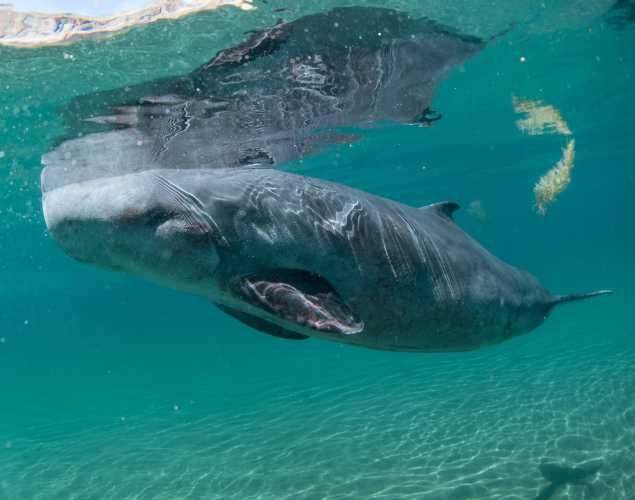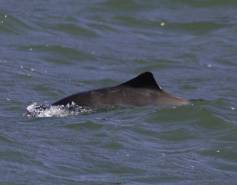
Population Structure of Pygmy and Dwarf Sperm Whales May Reflect Foraging Ecology and Dispersal Patterns
- Natural history
Abstract
Little is known about the biology of pygmy (Kogia breviceps) and dwarf (K. sima) sperm whales as these animals are difficult to observe in the wild. However, both species strand frequently along the South African, Australian and New Zealand coastlines, providing samples for these otherwise inaccessible species. The use of DNA samples from tissue and DNA extracted from historical material, such as teeth and bone, allowed a first analysis of the population structure of both species in the Southern Hemisphere. A 279 base pair consensus region of the mitochondrial cytochrome b gene was sequenced for 96 K. breviceps (53 tissue and 43 teeth or bone samples) and 29 K. sima (3 tissue and 26 teeth or bone samples), and 26 and 12 unique haplotypes were identified, respectively. K. breviceps showed a higher nucleotide diversity of 0.82% compared to 0.40% in K. sima. Significant genetic differentiation was detected in the Southern Hemisphere between K. breviceps from South Africa and New Zealand (ФST = 0.042, p < 0.05). Mitochondrial control region sequences (505 bp) were available for 44 individuals (41 K. breviceps and 3 K. sima) for comparative purposes. A comprehensive global phylogenetic analysis (maternal lineage) of our sequences together with all available Kogia mtDNA sequences largely supported previously published phylogenetic findings, but highlighted some changed inferences about oceanic divergences within both species. The higher nucleotide diversity and low population differentiation observed in K. breviceps may result from its broad foraging ecology and wide distribution, which may indicate a more opportunistic feeding behaviour and tolerance towards a larger range of water temperatures than K. sima.
Plön, S., Best, P.B., Duignan, P., Lavery, S.D., Bernard, R.T., Van Waerebeek, K. and Baker, C.S., 2023. Population structure of pygmy (Kogia breviceps) and dwarf (Kogia sima) sperm whales in the Southern Hemisphere may reflect foraging ecology and dispersal patterns. Advances in Marine Biology, 96, pp.85-114.
header photo © Sergio Martinez via Creative Commons
Pádraig Duignan
pygmy sperm whale, dwarf sperm whale, population genetics, Indo-Pacific, South Atlantic, population structure, geographic range
Related Publications
{"image":"\/Animals\/Wild\/Harbor porpoise\/cropped-images\/harbor-porpoise-by-bill-keener-c-the-marine-mammal-center-309-73-1207-943-1610670087.jpg","alt":"Harbor porpoise surfacing in the water","title":"The Sex Life of Harbor Porpoises: Lateralized and Aerial Behavior","link_url":"https:\/\/www.marinemammalcenter.org\/publications\/the-sex-life-of-harbor-porpoises-lateralized-and-aerial-behavior","label":"Research Paper"}

{"image":"\/Animals\/Wild\/Other species\/cropped-images\/stejnegers-beaked-whale-photo-c-marc-webber-0-0-949-742-1618440217.jpg","alt":"Stejneger's beaked whales","title":"Stejneger's Beaked Whale Strandings in Alaska, 1995\u20132020","link_url":"https:\/\/www.marinemammalcenter.org\/publications\/stejnegers-beaked-whale-strandings-in-alaska-1995-2020","label":"Research Paper"}

{"image":"\/Misc\/Graphics\/cropped-images\/marine-mammals-of-the-world-book-cover-wide-graphic-201-0-882-689-1618448911.jpg","alt":"Marine Mammals of the World book cover","title":"Marine Mammals of the World: A Comprehensive Guide to Their Identification","link_url":"https:\/\/www.marinemammalcenter.org\/publications\/marine-mammals-of-the-world-a-comprehensive-guide-to-their-identification","label":null}

Marine Mammals of the World: A Comprehensive Guide to Their Identification
Read More{"image":"\/Animals\/Wild\/Other species\/cropped-images\/striped-bass-shutterstock-754-2-4392-3430-1651011006.jpg","alt":"school of striped bass","title":"Seasonal Movement Patterns and Habitat Use of Striped Bass","link_url":"https:\/\/www.marinemammalcenter.org\/publications\/seasonal-movement-patterns-and-habitat-use-of-striped-bass","label":"Research Paper"}

Related News
{"image":"\/Animals\/Wild\/Hawaiian monk seal\/cropped-images\/hms-wild-photo-1-c-noaa-pifsc-hmsrp-35-0-1270-992-1759760452.jpg","alt":"A Hawaiian monk seal rests on its side on a sandy beach.","title":"Where Do Hawaiian Monk Seals Live? And Other \u2018\u012alio Holo I Ka Uaua Trivia","link_url":"https:\/\/www.marinemammalcenter.org\/news\/where-do-hawaiian-monk-seals-live-and-other-ilio-holo-i-ka-uaua-trivia","label":"News Update","date":"2025-10-06 00:00:00"}

Where Do Hawaiian Monk Seals Live? And Other ‘Īlio Holo I Ka Uaua Trivia
October 6, 2025
Read More{"image":"\/Animals\/Patients\/Elephant seals\/cropped-images\/es-hoffman47927-photo-by-bill-hunnewell-c-the-marine-mammal-center-124-0-1270-992-1748384535.jpg","alt":"An An elephant seal\u2019s face with long black whiskers and wide eyes emerges from the water. ","title":"Adaptations of the Deep: Seal Whiskers and Eyes","link_url":"https:\/\/www.marinemammalcenter.org\/news\/adaptations-of-the-deep-seal-whiskers-and-eyes","label":"Patient Update","date":"2025-05-28 02:00:00"}

{"image":"\/Animals\/Wild\/Humpback whale\/cropped-images\/humpback-whale-sea-lions-photo-c-bill-hunnewell-102-0-1270-992-1743014972.jpg","alt":"A California sea lion jumps out of the ocean next to a humpback whale showing its tail and another whale showing its back.","title":"What is the Loudest Animal on Earth? And Other Animal Trivia","link_url":"https:\/\/www.marinemammalcenter.org\/news\/what-is-the-loudest-animal-on-earth-and-other-animal-trivia","label":"News Update","date":"2025-03-26 07:00:00"}

{"image":"\/Animals\/Wild\/Guadalupe fur seal\/cropped-images\/gfs-wild-photo-by-marc-webber-193-0-1270-992-1739906952.jpg","alt":"A Guadalupe fur seal floats in the water with its flippers raised. ","title":"Your Visual Guide to Sea Lion and Seal Behavior","link_url":"https:\/\/www.marinemammalcenter.org\/news\/your-visual-guide-to-sea-lion-and-seal-behavior","label":"News Update","date":"2025-02-18 02:00:00"}


